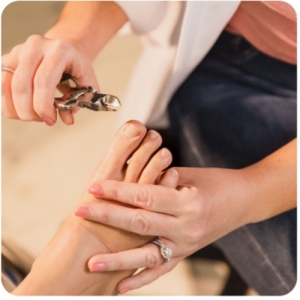Now more than ever we have seen people come in who haven’t had their toenails trimmed in a year or more. In these unprecedented times with the presence of COVID, this has become quite normal. Many people who need their toenails trimmed have underlying health conditions that put them in a high-risk category if they contracted COVID. These people stayed home for their health and safety, but many cannot reach their feet or don’t have the tools to properly trim thickened toenails. In one of our latest videos, I encounter a patient with these exact circumstances. We know that it can be nerve-racking to come to see a podiatrist after such a long time, but we are here to make the process as easy as possible! Here’s what to expect when you have your nails trimmed.
Why Are Toenails Difficult To Trim?
These toenails can be difficult to trim because they become hard and brittle. To make the process go smoother and more comfortable for the patient, we recommend that people soak their feet for approximately 30 minutes prior to coming in for their appointment. This will make the nails softer and easier to trim. The softer the nails are, the more we can trim at that appointment. Mod Pod Relaxis and Epsom salt soak also contains tea tree oil and an antifungal agent, which is a great combination to soften your nails before your appointment.
Updated Protocols
Some of you may be wondering why we do not soak the feet in the office like other providers such as the Toe Bro. Soaking feet in the office used to be the protocol when my grandfather was a podiatrist, but it has since changed. Studies have shown that reusing foot basins is more likely to transfer fungus and bacteria even after it has been cleaned. For sanitary reasons, soaking in the office is no longer the protocol. If a toenail is extremely thick, we will try to soften it with saline-soaked gauze, but for optimal results, it is best to soak just before your appointment. Applying Vick’s Vapor Rub to the nails daily will also help soften them, making them much more comfortable when the nails are trimmed.
Tools Used in Trimming
When toenails haven’t been trimmed in so long, it is natural for there to be a lot of debris and build-up around the edges of the nails. In addition to the dremel, I use a tool called a rasp to dig out all the build-up. The skin around the nails becomes sensitive after being covered by nail and build-up for so long, making this part a little uncomfortable. With routine maintenance every 9-12 weeks, this process will become easier and more comfortable for the patient. There won’t be as much build-up and we will be able to trim even more of the nail back.
Proper Sanitation
Once I am finished with the power-tools, a medical assistant comes in and cleans up excess debris and dust. Many people who have not had their nails treated in so long, also come with debris and dead skin in-between their toes. We want to make sure we clean all of this out because it is not only uncomfortable for the patient, but fungus loves to grow in-between the toes. Ensuring that these areas are clean and dry will reduce the chance of the patient developing a fungal infection such as athlete’s foot. After the clean-up is finished comes the best part: lotion. We use Mod Pod Nourish for all of our nail trim patients. Nourish contains a special combination of shea butter and grapefruit essential oils to provide their feet with essential hydration. This is often the patient’s favorite part because the lotion provides a soothing effect and they get a little mini massage when it is applied!
To help reduce the thickness of the nails in between visits, we recommend using Repair. A mix of essential oils increases moisture to your nail beds, while Urea’s antibacterial and anti-fungal properties help reduce thickness and works to restore a healthy nail.
Nail trims are billable to insurance if you have poor circulation or are diabetic. You can call at or text our office to schedule your appointment today!

